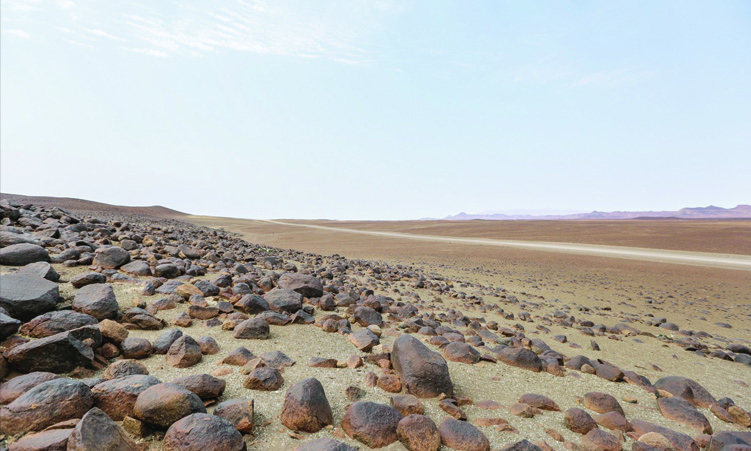Namibia’s first hydrogen project in the Erongo region could be challenged in identifying a water source – a key component of turning water into energy.
The project is considering using water from the Ugab River, a major source of water for wildlife in the Namib Desert.
Located at Dâures, the project is also looking at sourcing water from the Atlantic Ocean, situated about 140km from the site.
As of March, the implementers have spent N$37 million (16%) of the N$220-million grant from the German government to implement the project in 18 months – yet a water source has still not been identified.
The government selected the Dâures Green Hydrogen Consortium, led by Enersense Energy Namibia, to carry out the pilot project, which was launched last year.
This includes the Dâures Green Hydrogen Village comprising a production plant, community partnerships, green schemes and a fertiliser plant.
However, the project estimates it would need 2,2 billion litres of water.
Daures Green Hydrogen chief executive Jerome Namaseb this week told The Namibian the consortium has not decided on a water source yet.
He said the same in March.
“Water sources for the project will be determined in consultation with the relevant government agencies and ministries,” he said.
Experts say this amount of water is not possible to draw from the Ugab River without damaging the ecosystem.
“At this stage, it is still premature to share these details due to the fact that the final costing, including on the construction [of drilling boreholes] and ongoing maintenance, has not been finalised,” Namaseb said.
THE ATLANTIC
Another decision being mooted is to draw water from an existing desalination plant at the coast.
Namibia currently has one large-scale desalination plant, owned by the French government, called the Erongo Desalination Plant.
A second desalination plant is still being considered.
“We have not taken any decision of such nature, simply because several processes still need to undergo feasibility studies to determine viability and cost indicators,” Namaseb said.
Should none of the above options be viable, the consortium is allegedly considering the expensive option of drawing water directly from the Atlantic Ocean through a desalination plant.
“This is still to be assessed,” Namaseb said, adding that the hydrogen project has already started construction and currently employs 70 people.
“We are still in the adjudication process for some of the more specialist items such as the water waste package and clean energy package, but this should be awarded soon,” he said.
He insisted that the project is on track.
Daniel Frank, a senior water management adviser at Dechema e.V., says Namibia’s green hydrogen sector may need to use a desalination plant to generate sufficient water for production.
“To produce just 1kg of green hydrogen, approximately 10kg of water is needed through the electrolysis process.
“Given the scarcity of groundwater, sustainable and adequate water sources must be identified locally. Options such as seawater desalination plants and water reuse concepts are being considered to meet the increasing water demand for hydrogen production in the future,” Frank said this week during a presentation on behalf of the Namibia Investment Promotion and Development Board (NIPDB).
Namibia’s hydrogen commissioner and presidential economic adviser, James Mynupe, says he is not aware of the water challenges faced by Daures Green Hydrogen consortium.
“I was there last month and boreholes are already being drilled. But due to the magnitude of green hydrogen projects, we expect each and every project to utilise water from the ocean,” he says.

HIGH STAKES
Frack Free Namibia, an environmental watchdog group which has raised concerns about the impact of oil and gas exploration on the livelihoods of communities, this week said: “The green hydrogen scheme is predicated upon the availability of billions of litres of water while the surrounding communities have no access to water.”
The livelihoods of Daures village residents relies on agricultural activities, the group said.
The group said the option of a desalination sounds far-fetched as it’s impossible to complete in one year.
UNCHARTED TERRITORY
In its environmental and social impact assessment carried out last year, the consortium indicated that water supply would be obtained from the nearby settlement of Uis.
Uis and Dâures are 330km apart.
The report indicates that the consortium has identified seven borehole sites.
However, this process is regarded to not be feasible due to the number of boreholes that would need to be drilled for operational activities.
“These boreholes will be used to abstract water that will be utilised during the operational phase of the project for phase one. In subsequent phases, desalinated water would be extracted and piped from the Trekkopje mine about 100 km south of the project site.
“These rivers only flow during exceptional rainfall events,” the report reads.
The consortium in September last year held meetings where it presented the environment assessment report and highlighted potential risks.
One such risk was the spillage of oil when generators on site are being refuelled.
“Machinery and equipment used on site, such as the refuelling of generators, pose an environmental risk due to potential hydrocarbon spills.
“Hydrocarbon spillage could potentially contaminate the soil and groundwater,” the assessment report stated.
Other potential concerns include physical destruction and disturbance of the ecosystem and vegetation as a result of construction activities.
“This poses an environmental risk due to potential hydrocarbon spills,” the report said.
“Air quality … some dust will be generated from the activities which can pose an environmental impact and health impact on the surrounding community,” it stated.
- This story was produced by The Namibian’s investigative unit. Send us story tip-offs via your secure email to: investigations@namibian.com.na
Stay informed with The Namibian – your source for credible journalism. Get in-depth reporting and opinions for
only N$85 a month. Invest in journalism, invest in democracy –
Subscribe Now!








